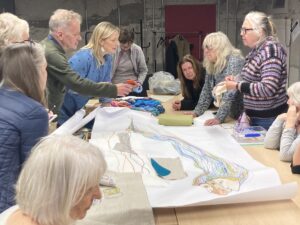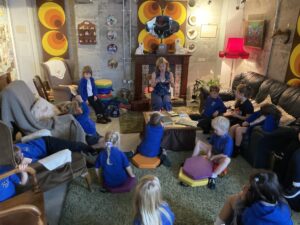Intangible Cultural Heritage: Gairloch Museum’s Festival of Stories
Gairloch Museum’s Festival of Stories enabled them to invite new and existing audiences into the museum space to share stories relevant to the local area, creating a powerful sense of community. Curator Karen Buchanan explores how they approached the project and the lasting benefits it has created for the museum.

Intro
Supported by the Year of Stories 2022 Community Stories Fund, Gairloch Museum delivered their first Festival of Stories in September 2022 – a programme of 16 imaginative storytelling events, many of which were hosted in a specially created ‘room for stories’ in the heart of the museum. This inclusive and participatory space brought the local community together to share stories – from ancient legends to local reminiscences – passing them on from generation to generation.
The project
During the Covid-19 lockdown, people became socially isolated and many of the activities enjoyed by the local community in and around Gairloch were stopped. Many activities were subsequently slow to restart and some people struggled to reconnect socially. Our Festival of Stories project was built around the idea of bringing the local community together in a ‘room for stories’; creating a ceilidh in the traditional sense of the word. People were invited to sit together around the fire to enjoy the talents of community storytellers and musicians and local history being passed from one generation to another.
To capture the feeling of sitting together around the fireplace we created a homely front room in the museum’s exhibition space with retro wallpaper, a fabulous McIntosh sideboard, tatty armchairs and a virtual fire projected onto a real hearth. The resources for the room were sourced by borrowing furnishings from people’s houses and from a generous house clearance business in Inverness called ‘Home Sweet Home’. As people walked into the room they were surprised by the cosy feel – many commenting on the warm-looking fireplace – and they seemed happy to settle into a comfy chair to enjoy the sessions.
The festival’s programme focused on stories relevant to the local area, told in many different forms. These included personal anecdotes, a graphic retelling of an ancient local fairy tale, the story of a local place rendered in song, visual storytelling by a local tapestry group, and Gaelic-language storytelling walks that explored the folklore behind the names of local flora. Every school in the local area visited the ‘room for stories’ and interacted with a storyteller.
I took [my son] in to see [your ‘room for stories’] and we sat for an hour reading his Minecraft books, helping to make the jigsaw and also helping to add a paragraph to the written story. It was lovely and he really enjoyed it. I really wanted your reading snug to stay.
Visitor to the Festival of Stories

Additional information
GRANT INFORMATION:
- Awarded £4,050 from the Year of Stories 2022 Community Stories Fund.
- This fund was delivered in partnership between VisitScotland and Museums Galleries Scotland with support from National Lottery Heritage Fund, thanks to National Lottery players.
- Received match funding of £210 from the Communities Mental Health and Wellbeing Fund.
Challenges and successes
- The festival was extensively promoted and attendances at all 16 events was good, bringing in 452 people from our rural community over ten days.
- It has highlighted the importance of place in the telling of stories – with audiences enthusiastically engaging with Gairloch’s ancient folklore, local history and the Gaelic language.
- Although the festival was well attended overall, turnout could have been higher for certain events. This may have been due to continued anxiety about Covid-19. With hindsight, we would have recorded more in-person events and shared them with a wider audience via YouTube.
The impact it has made
- The festival has helped the museum to develop new audiences. Many who attended multiple events were what we consider ‘regulars’; but equally, through the schools’ workshops, for example, many were introduced to the museum for the first time. There is evidence that this has resulted in independent follow-up visits by families.
- Several events launched at the festival have now been adopted as regular features, bringing in regular audiences. For example, the museum now hosts a hugely popular bi-monthly Ceilidh House open mic night, inspired by the festival’s Songs of Wester Ross event. We had been toying with the idea of this event for some time, and the festival gave us the opportunity to finally try it out – with great success!
- This project has been helpful in making the museum a place for the local community to come together, a place to feel comfortable to share stories and experiences. Creating the right environment has been an important part of this and we benefitted from testing out a new format and a new way of using our exhibition space.
Guidance
These are some recommendations for other museums planning a similar project.
- Be creative with your venue. Borrowing resources can help to make this more affordable, ethical and environmentally friendly.
- Try to help people feel at home, warm and comfortable. This will help to break down the barriers that can make some people feel nervous about visiting a museum and about sharing their own stories.
- Providing hybrid versions of certain events (i.e. in-person and online) may help to increase your audience. However, we wouldn’t recommend offering online-only events as we’ve found that in-person events create an invaluable opportunity for community-building social interaction.
Further information
If you would like further information about this project, please contact Karen Buchanan, Curator at Gairloch Museum, at curator@gairlochmuseum.org.uk.